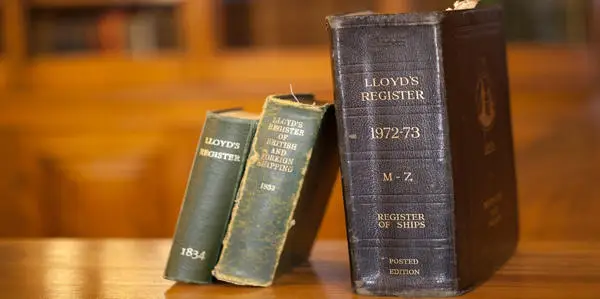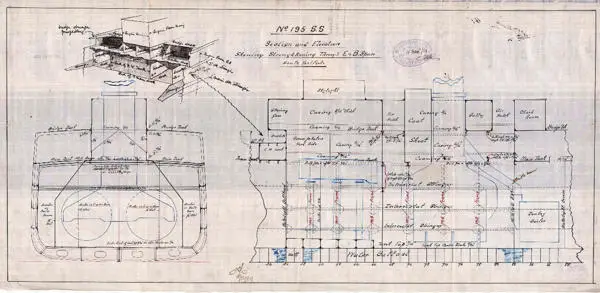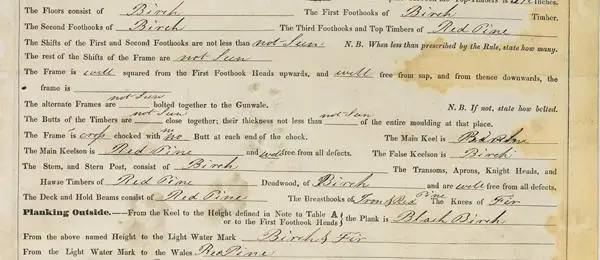Lloyd's Register digitisation project
Documents, Digitisation and Data: digitising Lloyd’s Register’s Ship Plan and Survey Report Collection
London Metropolitan Archives and Guildhall Library between them hold a significant amount of archive and printed material on maritime history, including ships, their movements and those who captained them, chiefly amongst the Lloyd’s of London collection. These sources are well-known to both maritime and family historians. Information on ships is also to be found in the collections of Lloyd’s Register which, like Lloyd’s of London, originated in the coffee house culture of the 18th century city, but as a completely separate institution which looks after its own archives. Here Michael Launchbury from the Lloyd’s Register Foundation, Heritage & Education Centre, writes about its history, and an ambitious digitisation project.

Since 2016, the Lloyd’s Register Foundation, Heritage & Education Centre has embarked on an extensive digitisation project to conserve, catalogue and digitise its historic Ship Plan and Survey Report Collection. The collection, which dates from the 1830s to the 1970s, holds over 1.25 million documents which detail the design, construction and maintenance of ships classed by Lloyd’s Register. Through survey reports, ship plans and handwritten correspondence, the collection highlights the important role Lloyd’s Register has played in the development of marine safety.
Though the collection dates from the 1830s, Lloyd’s Register has its origins in London’s coffee house culture of the eighteenth century. Of greatest importance to those interested in shipping, was Edward Lloyd’s Coffee House based latterly on Lombard Street in the City of London. In 1734, Lloyd’s List was first published and gave regular news updates on the movement of ships. The Corporation of Lloyd’s, otherwise known as Lloyd’s of London, through which underwriters discussed their business in marine insurance, also emerged from this coffee house. Lloyd’s Register, a completely separate institution, was established in 1760, to flesh out the news provided in Lloyd’s List, and present more detailed information on a ship’s seaworthiness.
From these humble origins Lloyds Register now has an archive reflecting its international reach. In a storage facility in Woolwich, London, sits a treasure trove of 1133 port boxes, from Aberdeen to Yokohama. The contents of each of these port boxes can vary. Most of these boxes hold a selection of survey reports; periodical surveys carried out by Lloyd’s Register surveyors that include information on a ship’s build, dimensions, owner, classification and voyage. But there is a plethora of other document types, such as telegrams, memos, forms, certificates, photographs and ship plans, highlighting the sheer diversity of the collection’s holdings and educational value. As the Ship Plan and Survey Report Collection has never been catalogued, the Heritage & Education Centre are frequently uncovering documents never seen before.

Many famed ships are included in the collection such as Cutty Sark, Mauretania and Bakuin (one of the earliest modern tankers, constructed in 1886). Lloyd’s Register has surveyed many technologically innovative vessels; two of which I will discuss in more detail.
Dunedin was the first ever vessel to transport refrigerated meat from New Zealand to London in 1882. This was the start of commercially viable transport of frozen meat and dairy. It opened markets in the northern hemisphere to the agricultural economies in the southern hemisphere, and subsequently transformed British food consumption habits and accelerated New Zealand’s early twentieth century economy. However, as with all innovative projects, there were a few issues. One unwanted problem was that the boilers used to power the refrigeration plant kept setting the sails on fire. On our website, we hold 17 documents for this vessel, including first entry reports, plans and a letter for expenses.
Sirius was the first iron vessel to be classed by Lloyd’s Register, receiving her ‘A’ classification in 1837 and appearing in the Register Book in 1838. No number of years was added to this classification as iron was still considered experimental in ship construction at this stage and she was subject to annual examinations. Sirius was constructed at William Fairbairn’s yard at Millwall for use on the River Rhône. Following the industrial revolution, shipbuilders were finding new materials, technologies and methods with which to build ships, moving away from wood and sail. Lloyd’s Register was cautious when it came to classifying new types of ships or technologies, preferring to describe them as 'experimental' and ensuring that they were checked regularly. Once proper knowledge and experience had been gathered of new materials or technology, then definitive classification rules would be issued. With iron, for example, the General Committee were happy to give any ship an 'A1' classification, if it 'was reported to be of good and substantial materials and with good workmanship' but readily admitted that they knew little about iron itself so could not give it a term of years. In 1855, the new Rules for Iron Ships was published with Lloyd’s Register recognising that the technology was still developing so the rules would have to adapt.
On a lighter note, the remarkable documents held within the archive depict the work and life of a Lloyd’s Register surveyor and their frequent dealings with shipbuilders, shipowners and, quite peculiarly, animals. Below you can find a report stamped with the paw prints of an insouciant cat… and the less said about the stains on the right the better.

Currently over 276,000 documents for over 45,000 ships are available to view and download, for free, on the Centre’s website. Each month this figure will grow by approximately 30,000. With a global audience spanning over 190 countries worldwide, the digitised collection is a unique resource that is being used by maritime historians, economists, linguists, ship model enthusiasts and family historians.
The digitised collection reinforces the Centre’s commitment to open access to the Heritage & Education Centre’s resources whilst also enhancing public understanding in marine and engineering science and history.
To view the digitised Ship Plan and Survey Report Collection, visit the Lloyd’s Register Foundation, Heritage & Education Centre website.